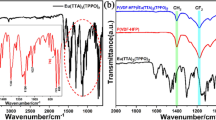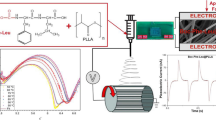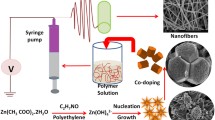Abstract
Multifunctional composite nanofiber membranes of Polyvinylidene fluoride and polyvinylidene difluoride (PVDF) and PVDF embedded with La3+ ion substituted for Pb2+ ion in Lead zirconate titanate (Pb1−xLax(ZryTi1−y)1−x/4O3) (PLZT) nanoparticles were fabricated using the electrospinning technique for the present investigation. The resulting composite nanofiber membranes were characterized for their microstructure, electrical properties, and mechanical strength. The observed PVDF/PLZT electrospun membranes characteristics demonstrate the presence of β-phase, as shown by FTIR and Raman spectroscopy. Furthermore, the pyroelectric and dielectric properties depend on the concentration of embedded PLZT nanoparticles, porosity, and electroactive β-phase content. The samples were subjected to stress under compression, shear, and torsion for their response, which indicates that the composites can be used for designing capacitive force-sensing devices. Based on the pyroelectric coefficient and real and imaginary parts of the dielectric constant, appropriate figures of merit were calculated to determine an optimum value for specific functionalities. Due to the vast range of potential applications, a brief overview of parametric considerations is discussed for designing flexible multifunctional sensor platforms, followed by future pathways.













Similar content being viewed by others
Data availability
Most of the data are available in the Results and Discussion section. Additional supporting information is available from the authors upon reasonable request.
References
ST Microelectronics, Life Augmented—MEMS and Sensors, https://www.st.com/en/mems-and-sensors.html. Accessed 20 July 2023
J. Xue, Electrospinning and electrospun nanofibers: methods, materials, and applications. Chem. Rev. 119, 5298–5315 (2019)
N. Bölgen, D. Demir, M. Aşık, B. Sakım, A. Vaseashta, Introduction and fundamentals of electrospinning, in Electrospun Nanofibers. ed. by A. Vaseashta, N. Bölgen (Springer, Cham, 2022)
A. Vaseashta, Loaded electrospun nanofibers: chemical and biological defense, in Nanostructured Materials for the Detection of CBRN. NATO Science for Peace and Security - A: Chemistry and Biology. ed. by J. Bonča, S. Kruchinin (Springer, Cham, 2018)
A. Vaseashta, D. Demir, B. Sakım, M. Aşık, N. Bölgen, Hierarchical integration of 3D printing and electrospinning of nanofibers for rapid prototyping, in Electrospun Nanofibers. ed. by A. Vaseashta, N. Bölgen (Springer, Cham, 2022)
N. Ashammakhi et al., Electrospinning and three-dimensional (3D) printing for biofabrication, in Electrospun Nanofibers. ed. by A. Vaseashta, N. Bölgen (Springer, Cham, 2022)
Z. Zhang et al., Integration of electrospinning and 3D printing technology, in Electrospun Nanofibers. ed. by A. Vaseashta, N. Bölgen (Springer, Cham, 2022)
A. Vaseashta, I. Stamatin, Electrospun polymers for controlled release of drugs, vaccine delivery, and system-on-fibers. J. Optoelectron. Adv. Mater. 9, 1606–1613 (2007)
H. Zarafshan, M. Mojarab, M.M. Zangeneh, P. Moradipour, F. Bagheri, F. Aghaz, E. Arkan, A novel biocompatible and biodegradable electrospun nanofibers containing M. Neglectum: antifungal properties and in vitro investigation. IEEE Trans. Nanobiosci. 21(4), 520–528 (2022). https://doi.org/10.1109/TNB.2021.3128407
H.M. Hashem, A. Motawea, A.H. Kamel et al., Fabrication and characterization of electrospun nanofibers using biocompatible polymers for the sustained release of venlafaxine. Sci. Rep. 12, 18037 (2022). https://doi.org/10.1038/s41598-022-22878-7
N. Bölgen, A. Vaseashta, Nanocomposites of electrospun polymeric materials as protective textiles against chemical and biological hazards, in Advanced Nanotechnologies for Detection and Defence against CBRN Agents. NATO Science for Peace and Security Series B: Physics and Biophysics. ed. by P. Petkov, D. Tsiulyanu, C. Popov, W. Kulisch (Springer, Dordrecht, 2018)
X. Hu, M. You, N. Yi, X. Zhang, Y. Xiang, Enhanced piezoelectric coefficient of PVDF-TrFE films via in situ polarization. Front. Energy Res. 9, 2021 (2021). https://doi.org/10.3389/fenrg.2021.621540
S. Palwai, A. Batra, S. Kotru, A. Vaseashta, Electrospun polyvinylidene fluoride nanofiber membrane-based flexible capacitive tactile sensors for biomedical applications. Surf. Eng. Appl. Electrochem. 58, 194–201 (2022). https://doi.org/10.3103/S1068375522020089
X. Dai, J. Niu, Z. Ren, X. Sun, S. Yan, Effects of nanoporous anodic alumina oxide on the crystallization and melting behavior of poly(vinylidene Fluoride). J. Phys. Chem. B 120, 843–850 (2016). https://doi.org/10.1021/acs.jpcb.5b11178
A.J. Lovinger, T. Furukawa, G.T. Davis, M.G. Broadhurst, Crystallographic changes characterizing the curie transition in three ferroelectric copolymers of vinylidene fluoride and trifluoroethylene: 2 oriented or poled samples. Polymer 24, 1233–1239 (1983). https://doi.org/10.1016/0032-3861(83)90051-4
R. Hasegawa, Y. Takahashi, Y. Chatani, H. Tadokoro, Crystal structures of three crystalline forms of poly(vinylidene fluoride). Polym. J. 3, 600–610 (1972). https://doi.org/10.1295/polymj.3.600
T. Masahiko, H. Sumio, M. Susumu, O. Nobuyuki, Some aspects of piezoelectricity and pyroelectricity in uniaxially stretched poly(vinylidene fluoride). J. Appl. Phys. 48, 513 (1977). https://doi.org/10.1063/1.323695
W.M. Prest, D.J. Luca, The formation of the γ phase from the α and β polymorphs of polyvinylidene fluoride. J. Appl. Phys. 49, 5042–5047 (1978). https://doi.org/10.1063/1.324439
N.C. Banik, F.P. Boyle, T.J. Sluckin, P.L. Taylor, S.K. Tripathy, A.J. Hopfinger, Theory of structural phase transitions in crystalline poly(vinylidene fluoride). J. Chem. Phys. 72, 3191–3196 (1980). https://doi.org/10.1063/1.439552
G.T. Davis, J.E. Mckinney, M.G. Broadhurst, S.C. Roth, Electric-field-induced phase changes in poly(vinylidene fluoride). J. Appl. Phys. 49, 4998–5002 (1978). https://doi.org/10.1063/1.324446
M. Smith, S. Kar-Narayan, Piezoelectric polymers: theory, challenges and opportunities. Int. Mater. Rev. 67(1), 65–88 (2022). https://doi.org/10.1080/09506608.2021.1915935
C. Zhang, H. Sun, Q. Zhu, Preparation and property enhancement of poly(vinylidene fluoride) (PVDF)/lead zirconate titanate (PZT) composite piezoelectric films. J. Electron. Mater. 50, 6426–6437 (2021). https://doi.org/10.1007/s11664-021-09172-4
J.X. Chen, J.W. Li, C.C. Cheng, C.W. Chiu, Piezoelectric property enhancement of PZT/Poly(vinylidene fluoride -co-trifluoro ethylene) hybrid films for flexible piezoelectric energy harvesters. ACS Omega 7(1), 793–803 (2021). https://doi.org/10.1021/acsomega.1c05451
S. Sukumaran, S. Chatbouri, D. Rouxel, E. Tisserand, F. Thiebaud, T. Ben-Zineb, Recent advances in flexible PVDF-based piezoelectric polymer devices for energy harvesting applications. J. Intell. Mater. Syst. Struct. 32(7), 746–780 (2021). https://doi.org/10.1177/1045389X20966058
J.C. Sampson, A. Batra, M.E. Edwards, A. Vaseashta et al., On the mechanisms of DC conduction in electrospun PLZT/PVDF nanocomposite membranes. J. Mater. Sci. 57, 5084–5096 (2022). https://doi.org/10.1007/s10853-022-06958-7
X. Yang, Y. Wang, X. Qing, A flexible capacitive sensor based on the electrospun PVDF nanofiber membrane with carbon nanotubes. Sens. Actuators A 299, 111579 (2019). https://doi.org/10.1016/j.sna.2019.111579
S. Hosseini, H. Hajghassem, M.H.F. Ghazani, A sensitive and flexible interdigitated capacitive strain gauge based on carbon nanofiber/PANI/silicone rubber nanocomposite for body motion monitoring. Mater. Res. Express 9(5), 065605 (2022). https://doi.org/10.1088/2053-1591/ac7851
D. Ponnamma, M.M. Chamakh, A.M. Alahzm, N. Salim, N. Hameed, M.A.A. AlMaadeed, Core-shell nanofibers of polyvinylidene fluoride-based nanocomposites as piezoelectric nanogenerators. Polymers 12, 2344 (2020). https://doi.org/10.3390/polym12102344
A.N. Nguyen, J. Solard, H.T.T. Nong, C. Ben-Osman, A. Gomez, V. Bockelée, S. Tencé-Girault, N. Schoenstein, M. Simón-Sorbed, A.E. Carrillo, S. Mercone, Spin coating and micro-patterning optimization of composite thin films based on PVDF. Materials (Basel) 13(6), 1342 (2020). https://doi.org/10.3390/ma13061342
A. Vaseashta, Controlled formation of multiple Taylor cones in electrospinning process. Appl. Phys. Lett. 90, 093115 (2007). https://doi.org/10.1063/1.2709958
C.C. Jin, X.C. Liu, C.H. Liu, H.L. Hwang, Q. Wang, Preparation and structure of aligned PLZT nanowires and their application in energy harvesting. Appl. Surf. Sci. 447, 430–436 (2018). https://doi.org/10.1016/j.apsusc.2018.03.251
C.J.L. Constantino, A.E. Job, R.D. Simões, J.A. Giacometti, V. Zucolotto, O.N. Oliveira, G. Gozzi, D.L. Chinaglia, Phase transition in poly(vinylidene fluoride) investigated with micro-Raman spectroscopy. Appl. Spectrosc. 59(3), 275–279 (2005)
L. Ruan, X. Yao, Y. Chang, L. Zhou, G. Qin, X. Zhang, Properties and applications of the β phase poly(vinylidene fluoride). Polymers 10(2), 228 (2018)
M.A. Hari, S.C. Karumuthil, L. Rajan, Optimization of PVDF nanocomposite based flexible piezoelectric tactile sensors: a comparative investigation. Sens. Actuators A 353, 114215 (2023). https://doi.org/10.1016/j.sna.2023.114215
S. You, J.K. Eshraghian, H.C. Iu, K. Cho, Low-power wireless sensor network using fine-grain control of sensor module power mode. Sensors 21, 3198 (2021). https://doi.org/10.3390/s21093198
A.K. Batra, M.D. Aggarwal, M.E. Edwards, A.S. Bhalla, Present status of polymer: ceramic composites for pyroelectric infrared detectors. Ferroelectrics 366, 84–12 (2008)
C.R. Bowen, J. Taylor, E.L. Boulbar, D. Zabek, V. Yu Topolov, A modified figure of merit for pyroelectric energy harvesting. Mater. Lett. 138, 243–246 (2015). https://doi.org/10.1016/j.matlet.2014.10.004
A.K. Batra, A. Alomari, Power Harvesting via Smart Materials, PM277 (SPIE, Bellingham, 2017)
A. Vaseashta, A. Batra, in Electrospun Nanofibers of High-Performance Electret Polymers for Tactile Sensing and Wearable Electronics, ed. by A. Vaseashta, M.E. Achour, M. Mabrouki, D. Fasquelle, A. Tachafine, Proceedings of the Sixth International Symposium on Dielectric Materials and Applications (ISyDMA’6). Springer, Cham (2022)
H. Guclu, H. Kasim, M. Yazici, Investigation of the optimum vibration energy harvesting performance of electrospun PVDF/BaTiO3 nanogenerator. J. Compos. Mater. 53(3), 409–424 (2022)
G. Kaur, D.S. Rana, Dielectric spectroscopic investigation and electrical conduction mechanism of PVDF-NiO nanocomposite thin films. J. Mater. Sci.: Mater. Electron. (2021). https://doi.org/10.1007/s10854-020-05209-2
S. Kohli, A. Saini, A.J. Pillai, MEMS-based capacitive sensors simulation for healthcare and biomedical applications. Int. J. Sci. Eng. Res. 4, 1855–1862 (2013)
B.F. Monea, E.I. Ionete, S.I. Spiridon, A. Leca, A. Stanciu, E. Petre, A. Vaseashta, Single wall carbon nanotubes based cryogenic temperature sensor platforms. Sensors 17, 2071 (2017). https://doi.org/10.3390/s17092071
N. Chamankar, R. Khajavi, A.A. Yousefi, A. Rashidi, F. Golestanifard, A flexible piezoelectric pressure sensor based on PVDF nanocomposite fibers doped with PZT particles for energy harvesting applications. Ceram. Int. 46(12), 19669–19681 (2020). https://doi.org/10.1016/j.ceramint.2020.03.210
L. Li, J. Zhu, W. Luo, Y. Li, Improved ferroelectric properties of (111)-oriented PbZr0.52Ti0.48O3 thin films on SrRuO3/Pt hybrid electrodes. Ferroelectrics 406, 121–129 (2010)
Y. Zhang, X. Xu, Machine learning band gaps of doped-TiO2 photocatalysts from structural and morphological parameters. ACS Omega 5(25), 15344–15352 (2020). https://doi.org/10.1021/acsomega.0c01438
Y. Zhang, X. Xu, Machine learning optical band gaps of doped-ZnO films. Optik 217, 164808 (2020). https://doi.org/10.1016/j.ijleo.2020.164808
R.K. Roy, Design of Experiments Using The Taguchi Approach: 16 Steps to Product and Process Improvement (Wiley, New York, 2001)
A. Vaseashta, Life Cycle Analysis of Nanoparticles Risk, Assessment, and Sustainability (DEStech Publications, Inc., Lancaster, 2015)
Acknowledgements
The authors thank Dr. M.D. Aggarwal for his support and encouragement. Thanks to Mr. E. Curtis for the fabrication of mechanical fixtures used in the present work. The authors acknowledge Mr. R. Paul for his technical assistance with scanning electron microscopy.
Funding
This work was partly supported by the Title III program under Historically Black Graduate Institutions (HBGI) programs at Alabama Agricultural and Mechanical University, USA.
Author information
Authors and Affiliations
Contributions
All authors contributed to the study’s conception and design. Material preparation, data collection, and analysis were performed by JS, AD, and JC. The first draft of the manuscript was written, edited, and finalized by AB and AV. All authors commented on previous versions of the manuscript. All authors have read and approved the final and revised manuscript.
Corresponding author
Ethics declarations
Conflict of interest
The authors declare no conflict of interest.
Institutional review board
Human subjects were not involved in this study.
Additional information
Publisher's Note
Springer Nature remains neutral with regard to jurisdictional claims in published maps and institutional affiliations.
Rights and permissions
Springer Nature or its licensor (e.g. a society or other partner) holds exclusive rights to this article under a publishing agreement with the author(s) or other rightsholder(s); author self-archiving of the accepted manuscript version of this article is solely governed by the terms of such publishing agreement and applicable law.
About this article
Cite this article
Batra, A., Sampson, J., Davis, A. et al. Electrospun nanofibers doped with PVDF and PLZT nanoparticles for potential biomedical and energy harvesting applications. J Mater Sci: Mater Electron 34, 1654 (2023). https://doi.org/10.1007/s10854-023-11066-6
Received:
Accepted:
Published:
DOI: https://doi.org/10.1007/s10854-023-11066-6




